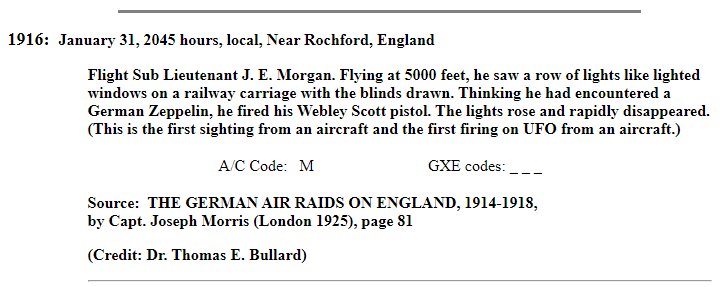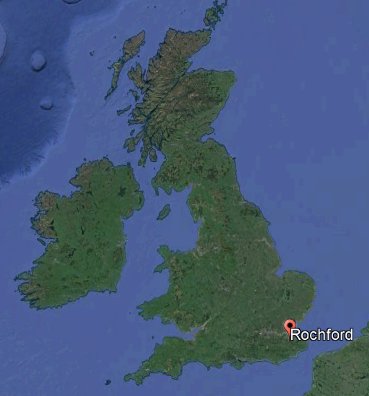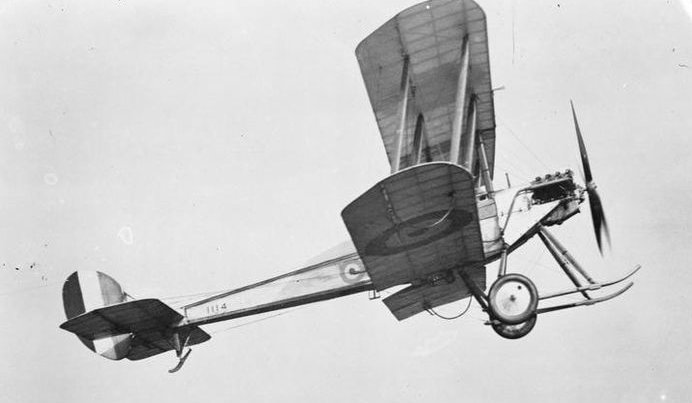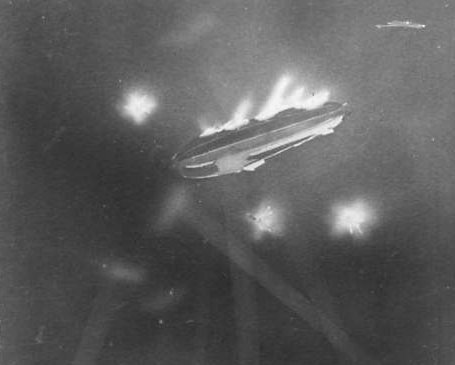French ufologist Dominique Weinstein compiled a catalog of the cases of UFOs observed from aircraft ([dwn1]). The first case in February 2001 (6th edition) catalog appears as:

|
| DATE | 16.01.31 |
| TIME | 20:45 LT |
| COUNTRY | UK |
| LOCATION | near Rochford |
| M | |
| TYPE OF PLANE AND WITNESSES |
pilot |
| UFO DESCRIPTION | one row of lights like lighted windows on a railway carriage. It rose and disappeared |
| Radar | |
| G | |
| X | |
| E | |
| SOURCES | 03 |
The source "03" is referenced at then end of the catalog as:
03 Project 1947 Reports, newsclippings and documents (cases from Jan Aldrich and Barry Greenwood)
On the Project 1947 website ([prt1], the case indeed appears with more details as:

|
1916: January 31, 2045 hours, local, Near Rochford, England
Flight Sub Lieutenant J. E. Morgan. Flying at 5000 feet, he saw a row of lights like lighted windows on a railway carriage with the blinds drawn. Thinking he had encountered a German Zeppelin, he fired his Webley Scott pistol. The lights rose and rapidly disappeared. (This is the first sighting from an aircraft and the first firing on UFO from an aircraft.)
A/C Code: M GXE codes: _ _ _
Source: THE GERMAN AIR RAIDS ON ENGLAND, 1914-1918, by Capt. Joseph Morris (London 1925), page 81
(Credit: Dr. Thomas E. Bullard)
A 2004 publication where this case appears was by Dr. David Clarke [dce1], on the Web on his website "The Real UFO Project":
Some 20 miles east of Hainault Farm was another of London's fighter aerodromes at Rochford in Essex. It was from here at 8.45pm that Flight Sub-Lieutenant J.E. Morgan arose for an anti-Zeppelin patrol in his BE2C fighter. Morgan, in an official report to the Admiralty, said that when he reached 5,000 feet he saw a little above his own altitude and slightly ahead to his right, about 100 feet away from his plane, "a row of what appeared to be lighted windows which looked something like a railway carriage with the blinds drawn."
Believing that he had flown directly into the path of a hostile Zeppelin preparing an attack upon Central London, Morgan drew his Webley Scott service pistol, aimed and fired several times in the direction of the "railway carriage." Immediately, "the lights alongside rose rapidly" and disappeared into the inky blackness, so rapidly in fact that Morgan believed his own aircraft had gone into a dive. By now Morgan had completely lost his bearings, and after a lengthy battle to bring his aircraft under control he was forced to make a crash landing on the Thameshaven Marshes.
A full account of Morgan's sighting, dubbed "an encounter with a phantom airship" appears in Captain Joseph Morris's official history of the German air raids, The War in the Air, published in 1925. The book was compiled from then classified records, and Morris refers directly to the airman's report filed with the War Office. Extensive searches of the Royal Flying Corps and Royal Naval Air Service records at the Public Record Office have failed to locate Morgan's original report. The station log from Rochford aerodrome does give brief details of Morgan's flight with the addition of the word "Zepp" which shows the pilot and his station commander believed he had had an encounter with something he took to be an enemy airship.
Morgan's report is not included in the official account of the 31 January, 1916 raid published by the War Office which charts the movements of the Zeppelins and the attempts by British fliers to intercept them in great detail. Historians have been left with the impression that the authorities gave no credence to his report. Here we have the first evidence of what has become a long tradition on the part of the War Office, and its successors the Air Ministry and today's Ministry of Defence, of 'down-playing' reports by military pilots of unidentified flying objects.
There was, in fact, additional support for the claim that an airborne object of some kind was present over London during the air raid. A fourth RFC pilot, McClelland, reported seeing what he described as "a Zeppelin" caught briefly in the glare of searchlights above London at 9 pm, 15 minutes after Morgan's encounter.
McClelland's report was in fact the subject of a comment by the Third Sea Lord, Rear-Admiral F.C.T Tudor, who dismissed it in one single paragraph which reads:
"night flying must be difficult and dangerous, and require considerable nerve and pluck, but this airman seems to have been gifted with a more than usually vivid imagination."
Historians of the Great War have used the phrase 'phantom airship' to describe inexplicable aerial phenomena. In later years broadly similar sightings were categorised by the largely baffled Air Ministry as ‘ghost planes' and ‘flying saucers.' Almost a century later we are no closer to explaining what was independently reported by four experienced pilots long before the phrase "UFO" was invented.
References:
David Clarke also reported on this sighting in his 2013 book "The UFO Files: The Inside Story of Real-life Sightings" ([dce2]).
He told that shortly before 8.30 p.m., two Royal Flying Corps pilots flying B.E.2c biplanes reported they were pursuing moving lights at 10,000 feet above Central London. Then they lost their targets in clouds, and, says Clarke, it seems possible they had actually spotted lights on each other's planes, but, he says, another sighting by a Royal Navy pilot is much more difficult to explain:
At 8;45 p.m. Flight Sub-Lieutenant Eric Morgan took off from the Royal Naval Air Service station at Rochford in Essex and began to patrol at 6,400 feet when his engine started misfiring, and this is when he saw, a little above his own altitude, slightly ahead to his right, about 100 feet away from his plane, "a row of what appeared to be lighted windows which looked something like a railway carriage with the blinds drawn".
He thougt he had come face to face with a Zeppelin preparing an attack upon Central London, so he drew his Webley & Scott pistol and fired. Immediately, "the lights alongside rose rapidly" and disappeared into the black sky, so rapidly that Morgan believed his own aircraft had gone into a dive. He struggled to bring his plane back under control and was forced to make an emergency landing on the Thameshaven Marshes.
Clarke says an account of Morgan's sighting, described as "an encounter with a phantom airship", appears in Captain Joseph Morris's official history "The German Air Raids on Great Britain 1914-18", published in 1925 and based upon then classified records. Clark notes that Morris refererd directly to the airman's report filed with the Admiralty, but this report is not mentioned in the official account of the 31 January 1916 raid published by the War Office which charts the flight paths of the Zeppelins and the attempts by British fighters to intercept them. As a result, says Clark, historians have been left with the impression that the authorities gave no credence to it.
The source given by Project 1947 and Dr. David Clarke, here, the book by Joseph Morris ([jms1]), is the earliest source I found so far about the incident. It gives this information:
There was a chase of phantom airship that night. Flight Sub-Lieutenant J.E. Morgan, who went up from Rochford at about a quarter to nine, was at 5,000 feet when, according to his report, he saw a little above his own level and slightly ahead to starboard, "a row of what appeared to be lighted windows which looked something like a railway carriage with the blinds drawn." Morgan thought that he had sighted a hostile airship only some 100 feet away, so he fired at it with his Webley Scott pistol, whereupon he says that "the lights alongside rose rapidly" and disappeared. Heading west he fired a Very light in the hope that he might be near an aerodrome, but he got no answering signal. He next discerned a "blur of yellowish light," which he thought might be Southend pier. On coming down, however, he discovered that what he had seen were the lights of a large Dutch steamer off Thames Haven. Flying round it he asked with his electric torch for his bearings, but the only answer he got was from the guns and searchlights of the Thames Haven defences. Morgan, knowing that these indicated "land or ships at sea" decided to descend. From the reflected light of one of the searchlight beams he made out a coastline to which he steered and came down into a "muddy water course." He was uninjured. With the help of some Royal Engineers he was able to extricate his undamaged machine from the mud, and thirty-six hours later he was able to fly his machine back to Rochford where he arrived on the afternoon of 2nd February. Four machines from Yarmouth and two from Castle Bromwich searched the mists in vain.
The book was first printed in 1925, the story appeared at page 76. In a 2007 reprint, it appears at page 81.
The Rochford sighting story, of course, appears on more than a dozen websites, as a summary, often without sources (Francis Ridge, NICAP; UFOdna, Think About It; Mike Swords; etc.
The story also appears in a self-published book titled "Lights Over Vicksburg Elucidation: The Thuran Curse", by Gary Nicholson, self-published, in 2021. Oddly enough, this book is supposed to be a fiction, an anti-war Science-Fiction story beginning in the Civil War era moving through time and into the future. In the book, one character reads this story to another character.
David Clarke's information also appears in "The Secret History of Southend-on-Sea", a book by De Dee Gordon, The History Press publishers, U-K., 2014.
The case had been already discussed in US ufologist Jerome Clark's book "Strange Skies" in 2003 ([jck1]); it was based on Captain Joseph Morris's book. Clark commented that for weather risks reasons, most Zeppelin attacks toook place between March and September, but that this is not proof that what Morgan saw was not a Zeppelin. He notes that what Morgan saw seemed however a little odd, and that the report is brief and somewhat cryptic, and that this may be or may not be the first pilot sighting of an unidentified flying object.

|
Apparently, from various military historical sources, the Rochford airfield, also known as "Hot Farm" apparently, was a Depot Squadron initially, becoming a Night Training Squadron with B.E.2c, B.E.2e & Airco DH.6s aircraft on September 15, 1916. Othe sources say it was a Home Defence Station from 1915 to 1918, used by the Royal Naval Air Service, and the Royal Flying Corps.

|
The Royal Aircraft Factory B.E.2 (B.E. meaning "Blériot Exprimental") was the first U-K. military plane, designed to be a stable reconnaissance platform, in 1912, before WWI, a time when the idea of fighter planes did not exist yet. The B.E.2c was ordered into production to replace the older B.E.2a and B.E.2b. The first production aircraft, built by Vickers, was delivered on December 19, 1914. The B.E.2c was used most effectively as a Home Defence aircraft; its stability became an asset, especially in night operations. Its slow rate of climb was still a problem, but no more than for any other aircraft used against the Zeppelins, which could gain height much quicker than any contemporary aircraft. Twelve squadrons would operate the B.E.2 on home defence duties, more than half of them from early in 1916. It had destroyed several Zeppelins by the end of 1916, forcing the Germans to abandon Zeppelin raids.
As can be seen from the primary source [jms1], it appears difficult, at least to me, to exclude that J.E. Morgan was not the victim of some misinterpretation. It appears that he was quite "lost" in the dark night.
The notion that he was "lost" appears qhen what he thought to be the Southend pier, he realized on coming down, "were the lights of a large Dutch steamer off Thames Haven".
Obviously, David Clarke located the "PRO Air 1/438 15/300/1. Rochford Station (Naval): report on night landing ground, 1916" report (date February 2, 1916?); from which he apparently got more details than from the book by Captain Joseph Morris. For example when the "UFO" went up, it was done "so rapidly in fact that Morgan believed his own aircraft had gone into a dive".
It is not certain that it was a misinterpretation of ground lights or ship lights. What seems to goes against it is that the "UFO" was "a little above his own level", and that after he fired at it, "the lights alongside rose rapidly", suggesting it was not something at ground-level. Also, he thought the "hostile airship" was only some 100 feet away, that is, very very close.
It is mildly possible that it was what Morgan first thought, a Zeppelin, able to climb quite rapidly; however, the "row of lights" do not make a good case for this.
So, I feel unable to decide what J. E. Morgan saw.

|
Above: Zeppelin caught in searchlights over Scotland, 1916. |
Unknown, possible misinterpretation, insufficient information.
* = Source is available to me.
? = Source I am told about but could not get so far. Help needed.
| Version: | Create/changed by: | Date: | Description: |
|---|---|---|---|
| 1.0 | Patrick Gross | August 2, 2021 | Creation, [jms1], [jck1], [dce1], [dce2], [prt1], [dwn1]. |
| 1.0 | Patrick Gross | August 2, 2021 | First published. |